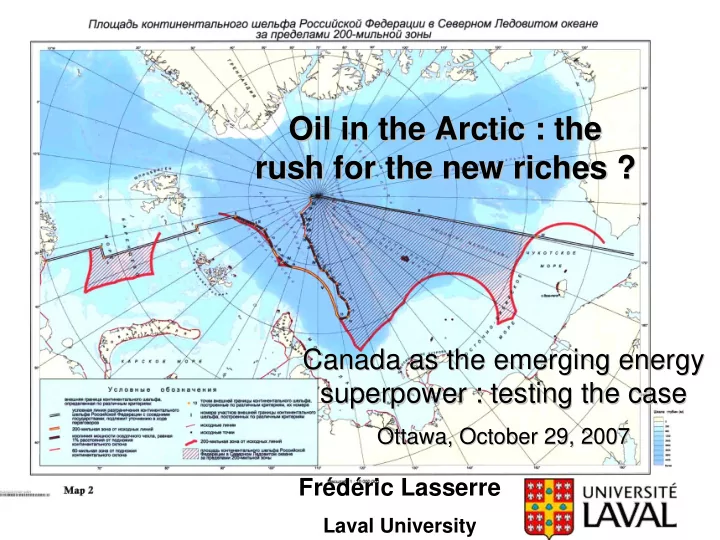

Oil in in the the Arctic Arctic : : the the Oil rush for the the new riches ? new riches ? rush for Canada as the the emerging emerging energy energy Canada as superpower : : testing testing the the case case superpower Ottawa, October October 29, 2007 29, 2007 Ottawa, Frédéric Lasserre Laval University
A new Eldorado ? • About 25% of oil to be discovered would be in the Arctic according to USGS (2000). • Discovered reserves 20 billion barrels of oil and 8 000 billion m3 • According to present estimations, the Arctic shelf contains about 80 percent of Russia's potential hydro- carbon resources. • Arctic’s estimated reserves : 200 billion barrels and 80 000 billion m3 • Alaska’s North Slope : estimated 50 billion barrels – USGS 2000 • Eastern Greeland, Fram Strait and Svalbard area : about 110 billion barrels, half of Saudi Arabia’s reserves ( Blog Finance July 19, 2006) • More than 22% of all known reserves of gas in the world are reportedly located in only one area in the north, in the Yamal peninsula (Rune Rautio, Barents Secretariat, BBC News, Aug. 13, 2006)
A comparison… Oil reserves (2006, billion barrels) • Saudi Arabia : 264,2 -> 27,1% of world total • Venezuela : 80,1 -> 6,6% • Russia : 79,2 -> 6,6% Gas reserves (2006, billion m3) • Saudi Arabia : 6 838 • Russia : 47 592
Hydrocarbon deposists all along the margins of the Arctic ocean
Norway • Snohvit : 161,5 billion m3 gas • Disputed area in Svalbard sea zone : 12 billion barrels oil equivalent – dispute ended in June 2007 so as to ease investments.
Russia • Barents and Kara Seas contain potential resources of : – between 50 (Institute of Energy Policy, Moscow) and 100 billion barrels (Society of Petroleum Engineers) – 3 200 billion m³ of gas. • Shtokmanovskoe gas field is probably the world's largest known offshore gas field. Its reserves total about 3 000 m3 of gas and more than 20 million tons of gas condensate. • BP signed a 17 billion $ exploration agreement with Russia
• Eastern Siberia (Laptev Sea, Lena basin) is one area where little exploration has taken place. • Only four or five oil and gas fields have been discovered up to 2006. • A 1996 Petroconsultants study (the latest available) estimated that – around 35 billion barrels of oil (3 billion proven in 2006) and – 141,6 billion m3 of natural gas exist in the region.
A need for new export routes
Canada Oil exploration is not new to the Canadian Arctic – during the 1970s and 1980s, policy of developing national resources Canada’s Discovered Oil and Gas Resources North of 60* Kenneth J. Drummond
The Canadian Arctic islands (Sverdrup basin) have reserves of 334 million barrels of oil, 493 billion m3 of gas.
August 2007 Exploration is is well well under under way way now now in in the the Canadian Canadian Exploration Arctic islands islands : : example example here here of of Sverdrup basin. Sverdrup basin. Arctic
An exploration frenzy for minerals as well is taking place F. Lasserre
Exploration is well under way • Oct. 2007 : Imperial Oil and Exxon paid 600 million $ for an exploration block in the Beaufort Sea, 120 km offshore.
Promising reserves… but not enormous • Total Canadian Northern oil reserves : 1 665 million barrels, – Of which 20,1 % in Arctic islands – 0,9% of Canadian oil reserves (incl. tar sands) ; 9,7% without – 0,6% Saudi Arabia’s reserves. • Total Canadian Northern gas reserves : 886,7 billion m3 – 55,3 % of Canadian gas reserves – 1,9 % Russia’s reserves
But then… • Devon Energy in Paktoa well (180 km north of Inuvik), 2006 : 240 M bbl, but not the billions of m3 of gas the firm had targeted
• According to a 2006 study by Wood Mackenzie and Fugro Robertson (energy research firms), the Arctic contains much less undiscovered oil than previous estimated, including the often- cited estimate from the 2000 U.S. Geological Survey report that said 25% of all the world's remaining oil would be found there… • The U.S. Alaskan North Slope would have an estimated 6 billion barrels of oil equivalent in undiscovered reserves, compared with a USGS assessment of more than 50 billion barrels. • The Arctic will more likely end up producing something closer to 3 percent of the world's oil when it is explored and developed in the coming decades, the report says.
Conclusion • Several more oil and gas fields are discovered as exploration is eased with the melting ice… and rising world prices • Arctic oil and gas remain difficult and costly to extract • Reserves may not be as dramatic as first thought.
Recommend
More recommend